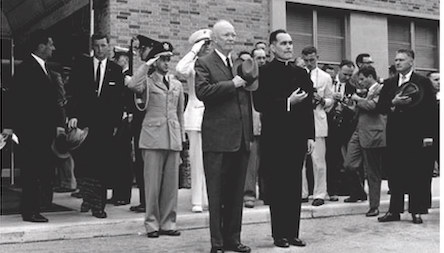
ReelBob: ‘Hesburgh’ ★★★½
By Bob Bloom
Fr. Theodore Hesburgh was a man of the cloth who wore many hats.
Hesburgh is best known as the president of the University of Notre Dame in South Bend, IN, a position he held for 35 years.
But he was so much more: A theologian, educator, facilitator, confidant, mediator, rebel, reformer and activist.
Over the years, Hesburgh interacted with presidents, popes, captains of industry and his beloved Notre Dame students.
Patrick Creadon’s 104-minute documentary, “Hesburgh,” looks at the life of this remarkable man who, at the age of 6, heard the calling for the priesthood.
Graduating from the seminary during World War II, he asked to be assigned as a Navy chaplain, but his superiors had other ideas. They told him he needed to earn his master’s degree, which he did.
After the war, working at Notre Dame, he helped many veterans adjust and enter school.
Hesburgh was born in 1917, and in 1952, was appointed president of the university, at the age of 35.
One of the major strengths of “Hesburgh,” which was written by William Neal, Nick Andert and Jerry Barca, is depicting the clergyman’s ability to connect with people.
As the movie explains, it was hard for a man who had taken a vow of poverty to learn how to ask people for money — but Hesburgh was so adept at socializing and making people feel at ease — that he exceeded expectations.
Along the way, he acquired such powerful friends as President Dwight D. Eisenhower, Martin Luther King Jr., David Rockefeller and President Bill Clinton.
It is because of Eisenhower that Hesburgh was introduced to social activism. In the mid-1950s, the president asked Hesburgh to be a member of a commission on atomic energy and the use of atomic weapons. His job was being the ethical voice of the group.
When a summit on atomic weapons was held, Hesburgh used his charms and wiles to bring American and Russian officials together so they could at least begin to bridge the gap that separated them.
In the late 1950s, Eisenhower appointed Hesburgh to a newly formed Civil Rights Commission, which included six other men — three Democrats and three Republicans, who also were divided equally along geographic lines — three Southerners and three Northerners.
Hesburgh was the member who continually prodded these men to look past their differences and put the nation ahead of their own beliefs and values.
All this while, he was still running Notre Dame and raising funds for the university.
A diverse aggregate of individuals, including former students, onetime government officials such as Leon Panetta, the late advice columnist Ann Landers — who was one of Hesburgh’s closest friends — and Notre Dame administrators who worked with and came after Hesburgh, pay tribute to the man and comment on his remarkable life.
Hesburgh was his own man: He bucked the Vatican when it ordered certain educational changes about what could and could not be taught at Catholic universities, and he turned against President Nixon over the war in Vietnam.
As described by many of those who, in the movie, talk about Hesburgh, he comes across as a man of conscience and conviction, who was willing to walk his own path no matter whom he rankled or angered.
He may have gathered some critics and enemies along the way, but he also inspired others and created a legacy of fairness, truth and honesty that went way beyond the halls of his hallowed university.
I am a founding member of the Indiana Film Journalists Association. My reviews appear at ReelBob (reelbob.com) and Rottentomatoes (www.rottentomatoes.com). I also review Blu-rays and DVDs. I can be reached by email at bobbloomjc@gmail.com or on Twitter @ReelBobBloom. Links to my reviews can be found on Facebook, Twitter and LinkedIn.
HESBURGH
3½ stars out of 4
Not rated